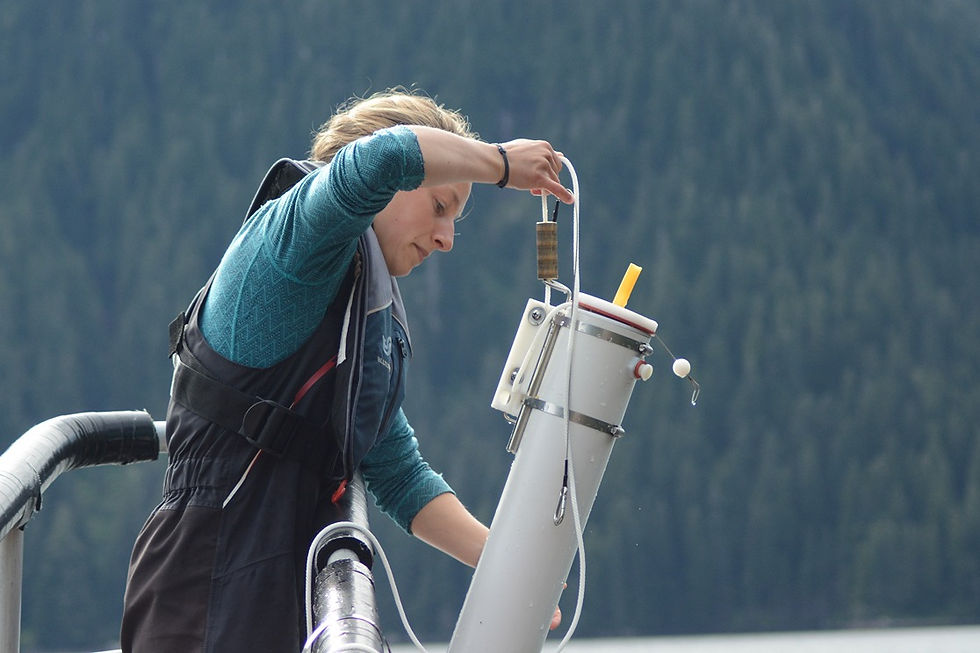The foraging habits of the three stooges
- AWF Team

- Jun 18, 2016
- 3 min read
The first part of this year’s field season at the Center for Coastal Conservation is already reaching its final few weeks. Fortunately, we have had two months full of surprisingly warm spring weather, amazing cetacean surveys, and numerous adventures while out hiking, bushwhacking, and kayaking. Since it is the beginning of the season and still early, it seems most of the humpback whales are still on their migration route from Hawai’i back to the cold and nutrient-rich waters of Alaska. Nonetheless, we have been fortunate enough to repeatedly encounter a few individuals in several locations along the eastern shores of Baranof Island. These encounters have enabled us to gain a better understanding of how these individuals forage.
As described by Jurasz & Jurasz in 1979, we know that bubble net feeding is a commonly seen feeding method of humpback whales in Southeast Alaska. Bubble net feeding can be displayed by solitary animals, small groups, and larger groups of 10-20 whales. In the larger groups, the whales work cooperatively with one another and each individual has its own role to play in this spectacular feeding event. While one humpback whale creates a bubble net by pushing air out of its two blowholes in order to herd small schooling fish, another whale uses vocalizations to force the prey to the surface. Other group members flash their pectoral fins, which are usually white on the underside, to push fish into the bubble net. As a last step of this group feeding behavior, the whales break collectively through the surface with their mouths wide open, taking in huge gulps of the aggregated fish.
What we have observed over the last weeks were slightly varied methods of solo or small group bubble net feeding, revealing each individual whale’s unique characteristics. I would like to give three different examples of feeding “styles”, shown by whales we have encountered on several occasions. It is important to mention that the behaviors described below were interpreted by us as human observers.

The whale “Hobo” (#2227), whom researchers from Professor Jan Straley’s Whale Lab (University of Alaska, Southeast) have been studying for years, is known to feed along the coastal vicinity of Baranof Island in early spring. We have witnessed her feeding on hatchery raised salmon in this region, which are generally released in early May and tend to stick to the protected shoreline before they start their migration to sea. “Hobo” developed a feeding technique which allows her to feed on small schooling fish, no matter what the tides do. Funny enough, we often observe her “sitting” on the shore bed when it is low tide, lifting her head high out of the water to successfully catch fish. In order to get closer to the rocks, and therefore to the fish, she will turn sideways and sometimes scrape the rocks with her pectoral fins. At times she also hovers above the ground, lifting her body high up, and flashing her white pectorals while searching for prey.

Another individual we have frequently observed is a juvenile humpback whale, who appears to be in his first stages of developing his own distinctive feeding technique. Every time he attempts to forage, he causes big splashes of water, and seems rather uncoordinated when doing so. There seems to be no steadiness or pattern to his movements. (Note: We were not able yet to match this individual in designated humpback whale Photo-ID catalogs.)

The third whale that has shown a very unique feeding technique acquired the nickname “Pelican” for good reason; whenever we observe this particular whale, he flaps his pectoral fins up and down, like a bird moves its wings to fly, to getting his head high out of the water. Once his baleen mouth is high above the water surface, he closes his mouth like a pelican scooping up its prey. Pelican has definitely shown the most spectacular feeding behavior, but whether it is more efficient than the other techniques remains a mystery. So how do humpback whales learn their behaviors and how long does it take them? Is it more efficient to come to East Baranof and feed on small schooling fish than going to different, maybe richer feeding grounds? How do these whales know at what time to arrive here? All these unanswered questions show how little we actually know about humpback whales and how much there is yet to be discovered.
Recently, sightings of these individual humpback whales have become rare. The most recent hatchery release of salmon smolt in this area dates back a few weeks now, and the lack of small schooling fish in the near shore areas may have forced the whales to move on to richer feeding grounds in other parts of Southeast Alaska. We are very grateful for the new knowledge we gained by observing these unique characters. See you next spring, guys!



Make your weekends full of fun when you have attractive Young South Delhi Escorts Service at your disposal. They are the happiest, most energetic, and most romantic people that never leave you without a good time and lasting memories.